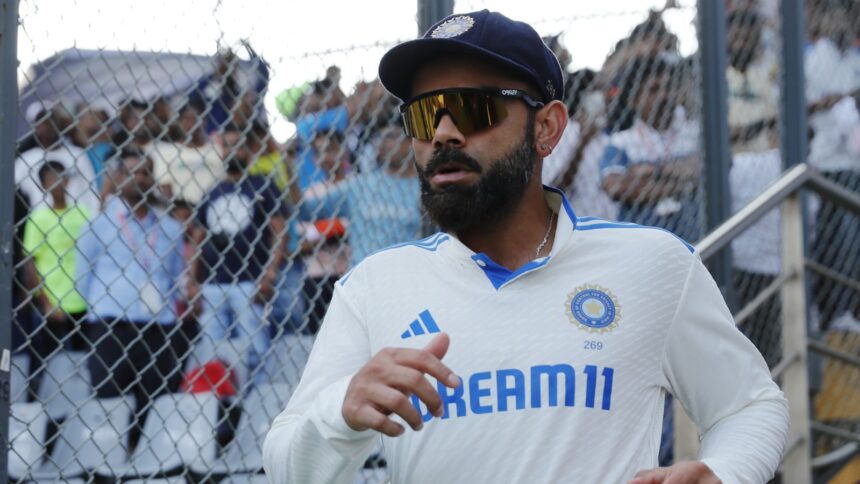For twelve years, Virat Kohli filled the most unfillable void in Indian cricket. Of Sachin Tendulkar. Of Virat Kohli. Across 123 Tests, 210 innings, 9230 runs, 30 hundreds, and numerous match-winning feats in an era when India became a force abroad, he was the soul and spine of India’s batting, its sustainer and destroyer.
Those were the best days of his life and the lives of many others too, which gave them meaning. As with Tendulkar, he was a hero of the masses, the one who was more than a batsman or a sportsman; an idol and an emotional investment, the numbers next to his name capable of both captivating and crushing the nation.
His legacy, as a Test batsman, is straightforward. He is one of the greatest that strode to bat for his country. A prolonged slump during the pandemic diminished his numbers, denying the once unstoppable fate of him conquering every batting peak in the game and breaking every possible record. The threads of fate work in strange ways, but Kohli bids goodbye as his country’s fourth-highest run-getter, behind Tendulkar, , and Sunil Gavaskar. The placing is a precise and hierarchical reflection of his stature in Indian cricket. Not the GOAT, but one of the GOATs.
A definite set of common virtues binds them all at this level—grandeur of stroke-making, firmness of technique, resolve of the mind, all-condition adaptability, and problem-solving knack. But in the middle, when the persona reflects as much as the style of batting, each one is unique. Gavaskar exuded unreal peace; Dravid was all inscrutable intensity; Tendulkar exhibited irreproducible masterfulness. Kohli emanated pure energy, unrehearsed and untrammelled, from the bottom of his heart, a vibe that filled the audience with a positive rage. Tendulkar generated love, Gavaskar awe, Dravid admiration, and Kohli an undulating buzz. He was the most mortal among them, a relatable, expressive and transparent man. He was without masks and pretences. The man you see was the man he often was.
He thus is a unique Indian batting great, more Javed Miandad than Tendulkar. He was not the stereotypically reserved and placid oriental great, but swaggering and hubristic, a true product of his times, uncompromising in his convictions and never taking a backward step or resting on past plaudits. He once revealed the essence of his batting to Nasser Hussain in a Sky Sports interview: “As cricketers and as sportsmen, we limit ourselves without even knowing how much we can do. I’ve never put any limitations on my life. If I get three hundreds in three innings, the fourth one is another opportunity.”
The audience could sense that energy when the squarish frame of sculpted perfection bristled out from the tunnel to the grass. His eyes were vibrant, the limbs restless to stamp their authority on the bowlers; he never ambled or strolled, but jogged or walked with short, fast strides. His batting conformed to the first law of thermodynamics, that energy could not be destroyed but transferred from one form to the other. From his eyes and limbs, it transmitted to the bat, to the sphere of leather and then towards the grass. The flow of energy—he let it rip, and not hide—reflected his mind and mood. There were days in recent times when it had seemed he was running on empty fuel tanks. A punishing self-critic, he could no longer take the feeling that he was not himself, that he was not feeling and feeding off that irresistible and organic energy.
His career was about harnessing and channeling that raw, wild energy. Unlike Tendulkar, he was not predestined for greatness; unlike Gavaskar, he didn’t soar into cricket’s collective consciousness in his first series; unlike Dravid, he didn’t marvel with technical purity. Rather, he built his career in blocks, step by step, moving closer to the best version of himself he could be. First came Kohli of uncontainable enthusiasm but with glitches, then appeared Kohli of the shredded abs but not entirely condition-proof, and then sprung the world-beater who surmounted everything he could in a five-year phase of luminescence.
The phase from late 2014 to late 2019 was the milieu of Kohli. Everything could be measured in the Kohli timeline. In just 90 outings, he stroked 5347 runs, more than half his overall numbers, composed 21 of his 30 centuries and maintained an average of 63.65. Hundreds arrived everywhere and every situation, against spin and seam. He defeated the devils of swing, reeled two hundreds against James Anderson and Co, repeatedly vanquished the Australian quicks and surfaces with five centuries and kept a 54-plus average in every country he had toured.
The upward curve, unavoidably, plateaued. There was no late-career rebirth like Tendulkar—which probably cost him the claim to be considered an all-era great—but the five-year period was the best phase of Indian cricket this century, the pinnacle being the first series win in Australia. Some of his finest knocks were etched during this time, like the 153 in Centurion, the twin hundreds in Adelaide, or the 149 in Birmingham. Australia and South Africa were his favourite overseas locales. His average of 49.50 in the Rainbow Nation is better than Tendulkar and Dravid; he tops the tally of hundreds in Australia by his countrymen too.
In the fixation with the overseas statistics, it’s convenient to forget how exemplary he was in India, where he was infallible at times. He averaged 55.58 to Tendulkar’s 52.67 and Dravid’s 51.35. He was the axis of India’s home invincibility from 2012 to 2024, a period of utter supremacy when they brushed adversaries aside.
He was not quite Tendulkar, but he was the closest India got to Tendulkar after his adieu. The pair differed in a lot of aspects, Tendulkar was more perfect and classical, kept evolving through the years and refined his game to such a consummate level that he made batting look utterly frictionless and routine, creating a sort of humdrum perfection. With Kohli, it was always a battle between his quest for perfection and the flaws that refused to die, a fascinating tussle in itself. There were fundamental deficiencies that could have revolted against him, like the bottom-handed cover drives, uncertainty outside the off-stump against the moving ball. But through practice and purpose, he ironed out the cracks that would have shaken the foundations of his batting and shoved him to the realm of imposters.
The burden on his shoulders were different; Tendulkar was thrust with the expectations of a developing, aspirational cricketing nation; Kolhi bore the brunt of a powerhouse that was mercilessly intolerant to setbacks and stumbles, when the sensibilities were more modern and dynamic.
In the end, it might have come to a point where he was not getting that vibe, the energy and the buzz that turbocharged his career. It was the way he played and the way he was, soaring and gliding and carrying you. The burden of being Tendulkar’s heir could have been suffocating, just as the pressure of being Kohli’s heir would be in the coming years.
And, he leaves Indian cricket with a void. The void of Kohli.









